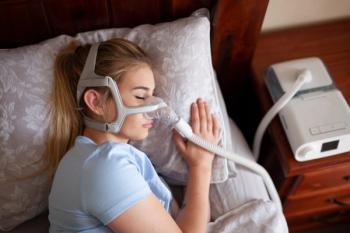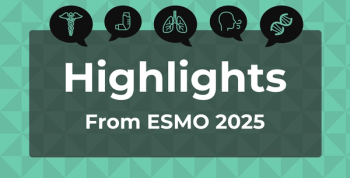
Mepolizumab Reduces COPD Exacerbations in Patients With Eosinophilic Inflammation
Key Takeaways
New findings from the MATINEE and COPD-HELP studies suggest mepolizumab could reduce exacerbations and improve quality of life in patients with eosinophilic chronic obstructive pulmonary disease (COPD).
Patients with
Findings from the COPD-HELP and MATINEE trials suggest the IL-5 inhibitor could reduce exacerbation rates and improve aspects of quality of life, particularly in individuals with longer-standing disease or those at high risk for hospitalization. Although the primary end points of these studies did not reach statistical significance, the observed quality of life benefits show the potential value of biomarker-driven therapy selection in COPD.
Mixed Results in COPD-HELP Trial
The COPD-HELP study enrolled 238 patients hospitalized with a severe COPD exacerbation and an eosinophil count of at least 300 cells/µL in the past year.1 Participants were randomized to receive either mepolizumab 100 mg or placebo every 4 weeks for 48 weeks. Researchers found no significant difference in time to readmission or death between groups; the median time to event was 25.4 weeks with mepolizumab and 26.1 weeks with placebo (HR, 0.96; 95% CI, 0.70-1.32; P = .811).
Although the study did not meet its primary end point, secondary outcomes favored mepolizumab. There were numerical reductions in both hospital readmissions (rate ratio, 0.89; 95% CI, 0.64-1.25) and moderate or severe exacerbations (rate ratio, 0.81; 95% CI, 0.66-1.00), but these were not statistically significant. According to the researchers, these trends are consistent with earlier studies showing mepolizumab’s efficacy in reducing community-treated exacerbations in eosinophilic COPD.
Greater Benefit in Long-Term COPD
The phase 3 MATINEE trial (NCT04133909) provided additional context for where mepolizumab may be most useful.2 This trial randomized 804 patients with a history of frequent exacerbations and blood eosinophil counts of at least 300 cells/µL to receive either mepolizumab 100 mg or placebo, both on top of triple inhaler therapy, for up to 104 weeks.
A post hoc subgroup analysis explored outcomes based on disease duration. Among those diagnosed with COPD for at least 9 years, mepolizumab reduced the annualized rate of moderate or severe exacerbations by 24% compared with placebo (95% CI, 0.60-0.97). This reduction was slightly less for patients who received their diagnosis less than 9 years ago, at 19% (95% CI, 0.62-1.06). Hospitalization rates also decreased more notably in the long-duration subgroup (rate ratio, 0.55; 95% CI, 0.32-0.93).
Although improvements in health-related quality of life measures such as the St. George’s Respiratory Questionnaire (SGRQ) and COPD Assessment Test did not reach statistical significance, trends again favored mepolizumab, particularly in those who received their COPD diagnosis at least 9 years prior. These findings suggest earlier identification and long-term management of eosinophilic inflammation may be key.
“Further data are needed to confirm if prompt treatment with mepolizumab results in better patient-reported outcomes,” the investigators said.
Quality of Life Gains Build Over Time
A separate MATINEE analysis focusing exclusively on health-related quality of life found that mepolizumab treatment produced greater improvements in activity limitations and psychosocial impacts than in symptom perception alone.3
Researchers used the least squares method—a statistical technique used in regression analysis—to estimate the average treatment effects of mepolizumab by adjusting for variability and minimizing error between actual patient outcomes and the model’s predictions. At week 52, the least squares mean reduction in SGRQ total score was –8.0 with mepolizumab compared with –5.7 with placebo (marking a difference of –2.3 (95% CI, –4.6 to 0.1).
Gains were particularly notable in the activity (–7.4 vs –4.9) and impact (–9.4 vs –5.4) domains, which focused on addressing disturbances to daily physical activities and psychosocial function, respectively. By week 104, the gap between groups widened in the symptom domain, with a difference of –3.1 points favoring mepolizumab. These findings indicate that mepolizumab’s effects on quality of life may grow with sustained use, particularly in aspects of physical and social functioning.
As payers look to reduce exacerbation-related hospitalizations, which drive substantial cost, eosinophil-guided biologic treatment could offer a more targeted, cost-effective approach for select patient populations.
References
- Flynn C, McAuley HJC, Elneima O, et al. COPD-HELP: a randomised controlled trial of mepolizumab initiated following admission to hospital for a severe exacerbation of eosinophilic COPD. Presented at: ATS 2025 International Conference; May 20, 2025; San Francisco, CA.
https://www.atsjournals.org/doi/10.1164/ajrccm.2025.211.Abstracts.A5546 - Roche N, Pavord ID, Sciurba FC, et al. Mepolizumab in patients with COPD: results from the MATINEE phase III randomized controlled trial. Presented at: ATS 2025 International Conference; May 20, 2025; San Francisco, CA.
https://www.atsjournals.org/doi/10.1164/ajrccm.2025.211.Abstracts.A5560 - Jones PW, Devouassoux G, Bafadhel, M, et al. Mepolizumab in patients with COPD: results from the MATINEE phase III randomized controlled trial. Presented at: ATS 2025 International Conference; May 20, 2025; San Francisco, CA.
https://www.atsjournals.org/doi/10.1164/ajrccm.2025.211.Abstracts.A5562
Newsletter
Stay ahead of policy, cost, and value—subscribe to AJMC for expert insights at the intersection of clinical care and health economics.







































